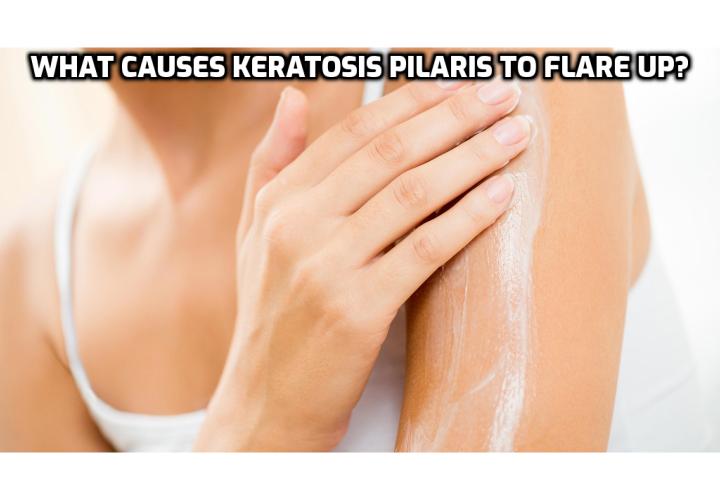Keratosis
Pilaris Causes and Complications - Other Skin Conditions That Bring About
Keratosis Pilaris
Keratosis pilaris occurs when small, acne-like bumps
appear on the surface of the skin in rough patches. These bumps are generally
located on the arms, thighs, buttocks, and occasionally the cheeks.
Individuals
experience keratosis pilaris as the result of the buildup of
keratin, a protective skin protein, in hair follicles. This keratin buildup
creates plugs that prevent hairs from pushing through to the surface of your
skin, which leads to unsightly, rough bumps on the skin's surface.
Although
keratosis pilaris can occur in otherwise-healthy
individuals, existing skin conditions can predispose you to developing this
disorder. The reasons behind the body's buildup of keratin are currently
unknown, but keratosis pilaris often appears to occur in
association with other skin conditions or genetic diseases in some patients.
Any
skin condition that involves dryness or moisture loss can contribute to
developing keratosis pilaris. For example, many patients
experience worsened symptoms during winter when humidity is low, as the harsh
weather conditions can prompt the skin to experience moisture loss.
People
with eczema (also known as atopic dermatitis) can be
prone to the symptoms of keratosis pilaris, as their itchy, dry, reddened
skin can be vulnerable to other skin problems.
Similarly,
individuals with ichthyosis who experience long-term thick, dry, and scaly skin
are also more likely to have keratosis pilaris as well. Although no clear
method of causation has been discovered, keratosis pilaris is also frequently
seen in those with xerosis, which involves symptoms like dry, irritated skin
that is cracked or feels tight, especially after bathing.
Keratosis
pilaris has also been associated with skin conditions that are related to allergic
reactions and asthma, although this has not received much clinical attention
yet.
Researchers
have noted that keratosis pilaris is often observed by physicians in
otherwise-healthy patients who are visiting dermatologists for the treatment of
other skin conditions and complaints.
If
you are experiencing a skin condition that is causing you concern or
discomfort, see your doctor or a dermatologist to diagnose and to address your
symptoms. He or she can suggest various therapies and over-the-counter treatments
to alleviate your discomfort and to promote well-moisturized skin.
Keratosis Pilaris
Causes and Complications - Possible Complications Of Keratosis Pilaris
Keratosis
pilaris is a widespread skin condition, affecting an estimated 40% of adults
and nearly 50% to 80% of adolescents worldwide. Individuals who suffer from
this condition have tiny, bumpy patterns along their skin; these rough areas
resemble permanent goose bumps or "chicken skin."
Although
keratosis pilaris is a common and relatively harmless skin condition, certain
patients may experience potential complications that range in severity from
minor itching to permanent scarring. If you are suffering from
keratosis pilaris and its associated complications and do not receive
appropriate treatment, you are at risk for permanent skin damage in the
affected areas.
For
some people with keratosis pilaris, the affected areas of their skin may
demonstrate temporary discoloration. Complications involving discoloration are
usually the result of changes in the skin's pigment, although this is not
common among keratosis pilaris patients.
Pigmentary
changes are referred to as either post-inflammatory hypopigmentation or hyperpigmentation, indicating conditions where
skin is either lighter than or darker than the surrounding tissue. As indicated
by their names, post-inflammatory hypopigmentation and hyperpigmentation generally follow a period of
prolonged or temporary inflammation of the affected area.
Additionally,
superficial scarring can also occur in some individuals with
keratosis pilaris. In general, any scarring in these cases is the result of
deep picking, overly aggressive treatment, or another source of inflammation.
Some patients may also experience a gradual loss of hair in
their affected facial areas, especially when keratosis pilaris occurs around
the eyebrows. Hair loss has not been associated with other affected areas
besides the face, however.
Thankfully, these complications usually disappear
with treatment. Keratosis pilaris rarely involves substantial complications, as
it is primarily a cosmetic skin condition. If you think you may be experiencing
keratosis pilaris or that your skin condition may be worsening, speak with your
doctor or a dermatologist. He or she can suggest treatments to protect your
skin and to reduce inflammation. He or she may prescribe a topical
corticosteroid cream or refer you for multiple laser therapies.
Additionally, your team of medical professionals can direct
you to the best at-home remedies, such as moisturizing twice a day or
installing a humidifier in your home.
For
more ideas on keratosis pilaris causes and complications as well as treatment,
watch this video - How
to treat Keratosis Pilaris (aka Chicken Skin)
This post is from the Keratosis Pilaris Remedy
program created by Alison White. Keratosis
Pilaris Remedy program is a step by step natural system through which
you can achieve a smoother and clearer skin in the shortest possible time. It
comes with a confidence-boosting skin cleanse that will help you in getting rid
of the Keratosis Pilaris condition.
You
will also get a recipe for a home-made face scrub with this product that is not
only very affordable to make, but also offer much more benefits as compared to
the expensive products available in the market.
The
author (Alison White) has also included her special Keratosis Pilaris diet
plan that includes some basic foods and make your skin to reborn and glow up
like your younger days.
Furthermore,
you will get the important information about the special ingredients that you
should consider while buying any skin product. These ingredients can be proved
very useful in eliminating the Keratosis Pilaris permanently.
To
find out more about this program, visit Keratosis
Pilaris Remedy Forever

No comments:
Post a Comment